Only You
Happy birthday to the federal government’s most recognizable environmental advocate
The U.S. Forest Service is a key actor in a lot of environmental and land use policy decisions. It oversees the national forests and handles various research and conservation efforts. The Service is a common defendant in environmental suits, often as a result of its substantial permitting duties. But what USFS is best known for is this guy:
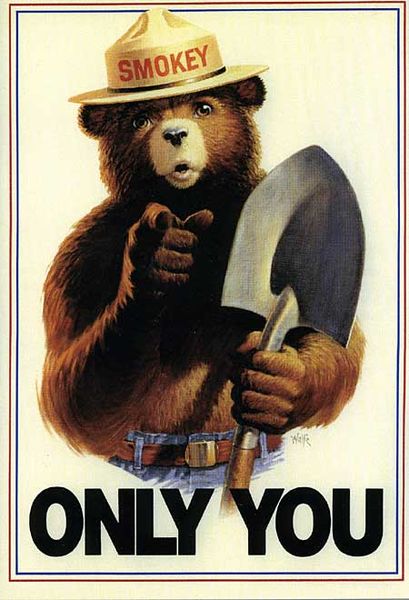
Smokey Bear debuted as a character on August 9, 1944 (or slightly earlier), making him 70 years old this week. In the spirit of summer (read: fire danger season) let’s take a moment to appreciate his history. A product of the Forest Service and the Ad Council, Smokey remains one of the most visible emblems of conservation, despite his age.
Junior Rangers will recall the sad tale of the real-life Smokey Bear:
In 1950, a tiny bear cub played happily in the forest. Somewhere in the forest, people were being careless with their fire. Soon the fire was burning out of control – a wildfire! Trees and bushes were in flames! Quick as he could, the tiny bear climbed a tree to save his own life. Luckily, someone called the ranger station, and before long firefighters were putting out the fire. A firefighter rescued the cub who was injured and very scared.
This Smokey Bear lived at the National Zoo until 1976. A celebrity in his lifetime and since, he was issued his own zip code to accommodate his enormous quantities of fan mail—in 1964, he received more mail than President Lyndon Johnson. Smokey has remained the third most recognized pop culture figure in America, following only Santa Claus and Mickey Mouse. Smokey’s message to those who might carelessly ignite forests is widely recognized: “Only you can prevent forest fires.” The message is simple, memorable, and compelling. Problem: wildfire. Solution: collective personal responsibility. Motivation: adorable man-bear.
Of course, Smokey’s snappy charisma is no accident. While there was a real-life Smokey, the character predates the cub. Smokey the character is a product of the Ad Council, the non-profit outlet for many federal agency advertising campaigns. Founded in 1942 and initially tasked with conveying wartime messages (the Council was known early on as the War Advertising Council), the Ad Council is responsible for many highly-memorable PSAs, from “Loose Lips Sink Ships,” to “A Mind is a Terrible Thing to Waste,” to “Just Say No.” In addition to Smokey, the Ad Council created the characters Rosie the Riveter, McGruff the Crime Dog, and the crash test dummies Vince and Larry. Ad Council campaigns have often carried an environmental theme, including the “Crying Indian” commercials in the 1970s, recent campaigns about discovering nature, recycling, and energy efficiency, and, of course, Smokey’s continuing crusade to prevent accidental wildfire.
Surprisingly, however, Smokey didn’t start as an environmentalist. As his uniform suggests, he’s a boy scout through and through, a hybrid of both park ranger and soldier. As Wendy Melillo details in her book “How McGruff and the Crying Indian Changed America” (the source for this post’s historical account), the Ad Council’s wildfire campaign for the Forest Service was initially motivated by concerns for national defense. The Japanese military had attempted to start wildfires on the U.S. coast, and the federal government was concerned about the possibility of massive fire cutting off its supply of wood, then a key ingredient of the war effort used for ships, gunstocks, and packing crates. According to William Mendenhall, Supervisor of the Angeles National Forest and “Forest Defense Coordinator” for Southern California, vigilance against accidental forest fires was “a big part of the job of defeating the Axis.” Early slogans to prevent forest fires reflected the fear that U.S. forest fires would advantage the Axis powers: “Our Carelessness, Their Secret Weapon,” and “Careless matches aid the Axis—Prevent Forest Fires,” and “Keep a Watchful Eye for Enemy Saboteurs.” One suggestion from the Ad Council, nixed by the Forest Service, asserted bluntly that “Carelessness is Treason” (for any readers who just took this year’s bar exam, this is not the correct standard for negligence). The posters used to convey these messages were barefaced war propaganda, featuring grotesque and starkly racist images. See below:
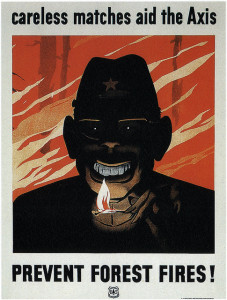
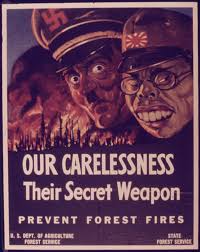
How did these images come to be replaced by America’s favorite bear? In 1944, with the end of World War II in sight, scare tactics weren’t working anymore. The Ad Council began a new campaign using Disney’s Bambi:
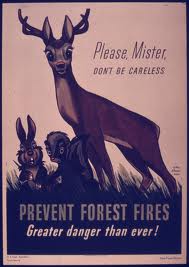
Bambi was good, but Disney’s ownership rights made use of the character unsustainable. Richard Hammatt, director of the Ad Council’s wildfire campaign, had a very specific idea for the next face of wildfire prevention:
Characterization (Disney manner?) of a (cub?) bear in a green (unburned) setting. Nose short (Panda type), color black or brown; expression appealing, knowledgeable, quizzical; perhaps wearing a campaign (or boy scout) hat that typifies the outdoors and the woods. A bear that walks on his hind legs; that can be shown putting out a warming fire with a bucket of water; dropping by parachute to a fire; reporting a fire by phone from a lookout; plowing a fire-line around a new-made clearing; building a campfire in the right place and way; carrying a rifle like G.I. Joes, etc.
Which, of course, would look something like this:
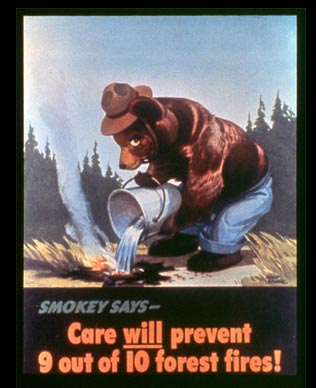
“Only You” debuted a few years later. Today, the Smokey character is still going strong. A recent campaign features a CG Smokey with a considerably less timeless slogan, “Get Your Smokey On.” You’ll see Smokey at National Parks and Forests, and on fire danger signs beside roads. Unauthorized use of his likeness is a violation of federal law, and can get you 6 months in jail, a copyright protection Disney could only dream at.
According to the Ad Council, thanks to Smokey, annual forest fire losses have dropped from 22 million acres in 1944 to under 8 million acres in 2004. This is probably giving Smokey too much credit, though. Today, 9 out of 10 forest fires are still caused by carelessness. Not everyone loves Smokey, either. As Melillo explains, by casting blame on anyone starting fires, Smokey has been accused of discouraging those would use land for grazing, while supporting potentially larger consumptive uses by the timber industry and other cutters.
Putting these concerns aside, though, Smokey is compelling; he may be the most charismatic megafauna of them all. His magnetism is unrivaled by would-be successors Woodsy Owl, Puddles the Blue Goose, and Johnny Horizon. Smokey’s “Only You” catchphrase, introduced a few years after the bear himself, inspires a unique public engagement with the environment, however small, that has stood the test of time. His emphasis on prevention remains important. And, of course, wildfires remain a serious issue; the Yosemite El Portal Fire is just the latest in an ongoing string of California wildfires expected to get worse as a result of climate change. Smokey may not be able to fix the problem entirely, but he will certainly let you know it exists. Given the common difficulty in bringing attention to environmental issues, that may be worth something.






Reader Comments